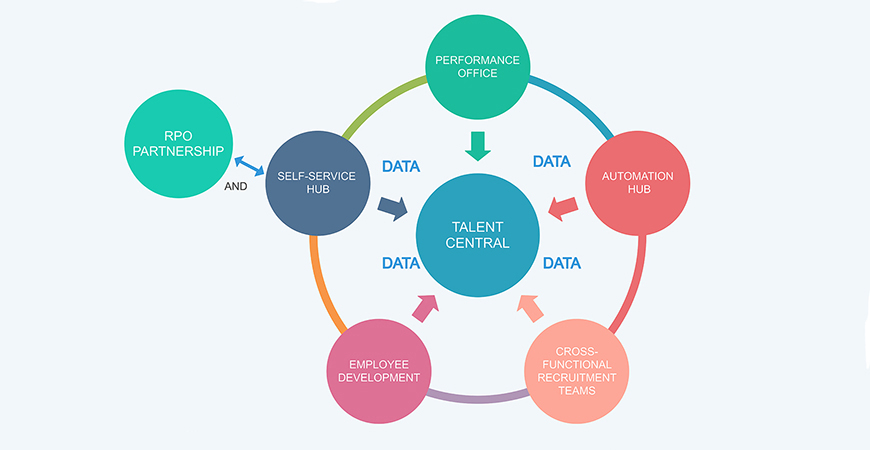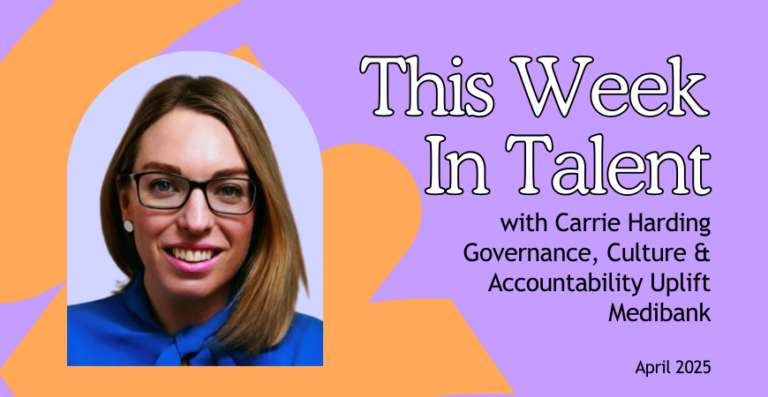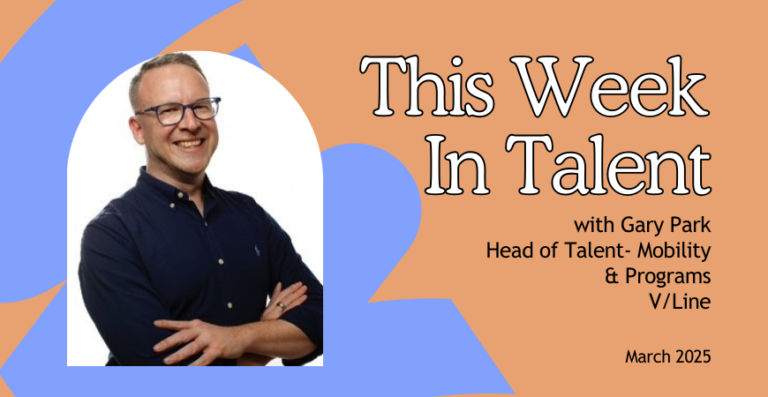Being able to recruit hard-to-find, high-quality Talent quickly is a clear win for any organisation, making it better able to compete and innovate. Today’s recruitment functions usually act too slowly, often lack knowledge about the business and the skills needed, and hinder efficiency with complex administrative systems. They do not meet the expectations of many candidates or hiring managers accustomed to fast service and prompt feedback.
As it is organised and chartered today, it is apparent that recruitment is a vestige of the 20th century, manufacturing era organisations, and needs to be radically disrupted.
Is there a better way?
A new model
Figure 1 below lays out the elements that might be required for future Talent teams.
The proposed organisation does much more than recruit. It assumes the responsibilities of Talent management, employee development, and succession planning. It becomes the overall Talent arm of the organisation. It is responsible for making sure the organisation has the skills and people it needs to meet any future requirements.
This means that it must be agile and highly responsive. It needs to attract all types of Talent, whether permanent, freelance, or consultant. And it needs to do this either through its own processes or by utilising RPOs or other external resources.
It must also be continuously aware of emerging skill needs and provide coaching and learning opportunities for internal employees.
Structure
Good design requires both robustness and flexibility. A function must be robust enough to perform under lots of different conditions, including unanticipated requirements, external disruptions, and a range of decision-making styles. And the function also has to be flexible enough to adapt and accommodate new requirements.
Most recruitment functions are set up as hierarchies. Everyone has a defined set of activities and rarely feel comfortable doing anything outside of those activities. Even though there are “full-stack” recruiters, for the most part, the profession has become very specialised.
Sourcers source candidates; recruiters interview candidates, do the legal and administrative work, and interface with managers; HR sets policies; hiring managers define the roles they need and set job requirements. Everyone pretty much works in a silo with minimal cooperation or consultation with each other.
The people in each function feel that they are communicating and cooperating, but almost all issues arise because they don’t do this very well. I have interviewed scores of hiring managers over the past two years and very few have good things to say about recruiting.
The general feedback falls into two categories: too slow and administratively burdened, or not savvy enough about the roles they are seeking or the business.
Time is ripe for a new structure and a new way of doing recruiting. The new model is network and team-based. Each component is connected to others through actions and data.

Performance office
The performance office is the strategy development and overall integrator of numerous elements needed for a complete picture of Talent. It is responsible for making sure the organisation has the skills and people it needs to meet any future requirements.
It is designed to set standards, negotiate with vendors, use data to decide on whether to recruit or develop needed skills, work with the automation hub to select tools and integrate them into the various functions, and coordinate activities between the various hubs.
Automation hub
Automated tools paired with artificial intelligence can offer candidates a personalised experience with relevant and engaging content. They can also screen and assess candidates and recommend selected candidates for hire with increasing accuracy. These tools can find suitable candidates, communicate with them, and do the administrative tasks associated with hiring.
Given that recruiters are not technologists and should not be, creating an automation hub makes sense. In such a hub, a team of technicians, analysts, and recruiters work together to select, implement, and continuously improve recruitment tools, the career site, assessment, and application processes.
This relieves recruiters from trying to do what it lacks the expertise to do and provides candidates the experience they expect – quick service, feedback, and prompt decisions. This hub simplifies and automates the administrative tasks associated with recruitment.
Self-service hub
A large component of recruitment can be self-service.
We have become accustomed to conducting transactions and making choices using automation. We buy things sight unseen from Amazon; we do all our banking virtually, buy stocks, and trade online, and increasingly we even get our medical care using telemedicine. It is only logical that we also allow candidates and hiring managers to find each other and communicate without any recruiter involved.
We can assess candidates using a wide variety of accredited, online tools. Managers can interview with video and generate offer letters, employment contracts, and do all other administrative requirements virtually if we have the proper automation hub.
Giving candidates and managers an option to use these tools would be the first step to a totally automated recruitment capability. There are only a few cases where we need extensive human-to-human direct contact.
Cross-functional recruitment teams
In the cases where direct human-to-human contact is necessary, ad hoc recruiting teams that are formed and disbanded as needed can be charted. They can be focused on hiring a vertical, or on global hiring, or whatever is needed.
Hiring managers become key members of the team and assume responsibilities, and take actions that might have been done by a recruiter. The team could, for example, include a marketing professional to enhance the attraction of opportunities and provide targeted messaging and social media advertising. A technical expert would help make sure the selection criteria are appropriate and help in the assessment. This web of allied employees can greatly increase the speed and efficiency of finding and hiring the right people.
Cooperation and sharing become normal, and the hierarchies are gone. Individuals who formerly worked in functional silos can expand beyond narrowly defined roles, take on new roles, learn, and bring fresh ideas.
Employee development
Being able to develop Talent is an integral part of any Talent strategy. An organisation needs the ability to analyse the skills of existing Talent, assess the availability of the skills it needs in the marketplace, and develop those skills internally and externally when the supply is constrained.
By integrating recruitment and data analytics with development, the organisation can proactively find ways to accelerate skill development.
Data & analytics
To enhance the automated tools’ ability to make good decisions and be sure information is available to the recruiting team, there must be the capability to gather and analyse all sorts of data about people.
This includes assessing skills, analysing work patterns, measuring performance, and correlating skills and abilities with the work that needs to be done.
This is not possible today with our manual systems and the inability to collect and analyse large data sets. And, given today’s hierarchical structures, information is gathered slowly and filtered before getting to decision-makers. This leads to large time gaps between collecting data and presenting the analysis of that data, even when it is possible. With automated processes, data is available on-demand.
By restructuring into teams and accessing and analysing the data across multiple functions, it will be possible to do better correlations and provide more accurate predictive and even prescriptive results.







